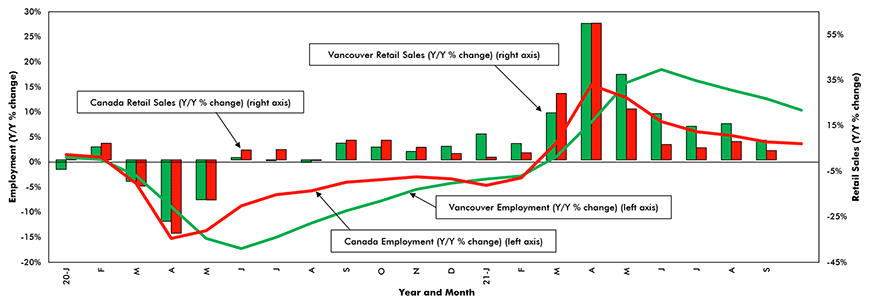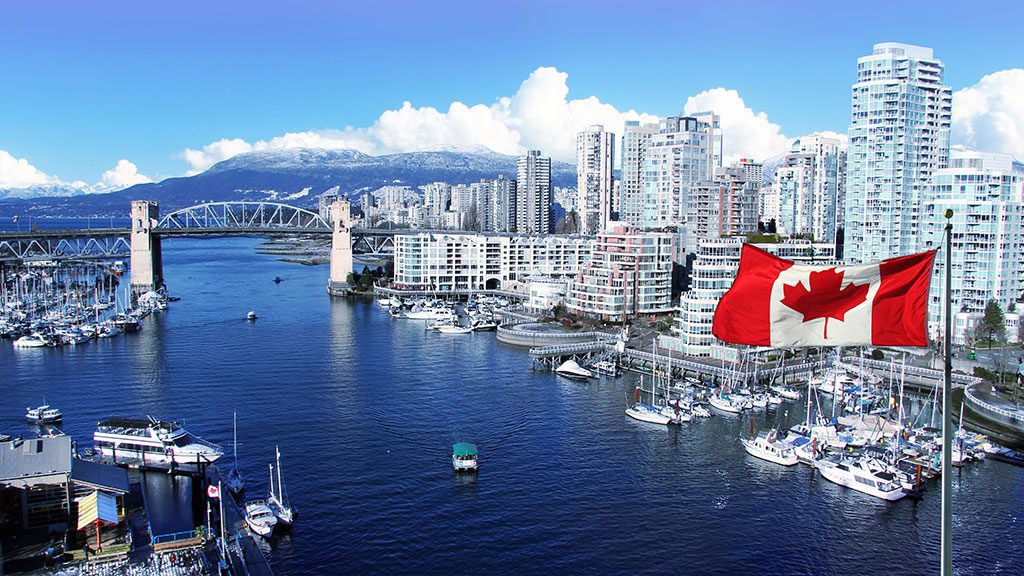The major flooding in the Fraser Valley and the southern interior of British Columbia will exacerbate the pre-existing supply chain issues which have weighed on economic activity in the province as a whole and, to a lesser extent, Vancouver for the past several months. Further, the severing of roads and railroads supplying the city will temporarily dampen the CMA’s goods-producing industries by restricting their ability to import essential inputs.
It is worth noting, however that, due in part to more than 90% of Vancouverites being fully vaccinated, the latest (October) employment numbers indicate the city’s economic pulse is the second most vigorous among Canada’s 35 census metro areas (CMAs). Since the beginning of 2021, the city has added +83,300 jobs, all full-time. Almost all the new hiring or rehiring has occurred in the service sector, led by ‘wholesale and retail trade’ (+40k jobs), followed by ‘health care and social assistance’ (+27K), then ‘public administration’ (+15k).
Hiring in the goods-producing sector year to date has been negligible (+1k jobs), with gains in manufacturing (+6k) largely offset by declines in utilities (-1.5k) and construction (-2.3k). Vancouver’s unemployment rate, currently 6.5%, is not yet back to its pre-coronavirus low of 4.3%.
Expect consumers to fuel growth in 2022 and 2023
Fuelled by the combination of robust gains in employment, plus rising consumer confidence and record low-interest rates, consumer spending in Vancouver, as reflected by retail sales, recently posted a year-to-date increase of +20.5%, the second-best performance among Canada’s nine major metro areas. Sales of motor vehicles and parts, up by +50%, made the major contribution to the year-to-date gain, followed by gasoline stations, where the price of petrol has increased by +23% since the beginning of this year. The +23% for B.C. is well under the average price jump of +36% for the whole country.
Going forward, the combination of persisting relatively low interest rates, sustained net in-migration of residents and ongoing healthy hiring plans should underpin consumer spending throughout 2022 and into 2023.
After a record high in 2021, expect home sales to cool in 2022
After posting a solid +18% y/y gain in home sales in 2020, Vancouver’s housing market has gone into orbit this year. Year-to-date sales of existing homes are up by +56% to a 10-month record of 46,000 units.
The three key factors driving this acceleration include a record +105% year-to-date (through September) increase in admissions of permanent residents, the already mentioned hearty full-time jobs growth, and record low-interest rates.
The slowdown in applications to build both single-family and multi-family dwellings year to date suggests that residential construction will cool in 2022. At the same time, the effects of a significant deterioration in affordability in the third quarter, reflected by the Royal Bank’s Housing Affordability Measure, together with expected hikes in mortgage rates, will contribute to a softening in demand. This erosion of demand, combined with slower growth of supply, will cause B.C. housing to start to slow from an estimated 25,000 units in 2021 to 23,000 in 2022 and 22,000 in 2023.
Non-residential construction to pick up in 2022 and 2023
The lingering impact of the COVID-driven drop in office-based employment in 2020 and the accompanying rise in office vacancy rates are largely responsible for investment in non-residential building construction taking a tumble year to date in 2021 of -21% (i.e., through September), on the heels of a -8% drop in 2020.
Several indicators suggest the pace of non-residential construction in Vancouver will accelerate in 2022 and 2023. First, the high level of vaccination in the metro area significantly reduces the risk of infection for workers, as more firms encourage their staff to return to the office. After a period of almost steady shrinkage from the second quarter of 2020 on, the absorption of vacant office space increased in the third quarter of this year and the vacancy rate declined in Vancouver Central Area.
Also, the steady rise in business openings since mid-2020 will lead to an increase in demand for industrial and commercial space.
Third, in its April budget, the provincial government announced plans to increase infrastructure investment by $3.5 billion, a significant amount of which will flow to the Vancouver CMA. Major projects in the pipeline include the extension of the Millennium SkyTrain line, the replacement of the St Paul’s Acute Care Hospital, the Broadway Subway project, and the King George Station mixed-use development.
John Clinkard has over 35 years’ experience as an economist in international, national and regional research and analysis with leading financial institutions and media outlets in Canada.
Retail Sales and Employment
(Year-over-Year % change) – Vancouver vs Canada

Chart: ConstructConnect — CanaData.
Please click on the following link to download the PDF version of this article:
Economic Snapshot Vol. 19, Issue 22 – Fraser River flooding to dampen, but not drown, Vancouver’s economy – PDF


Recent Comments
comments for this post are closed